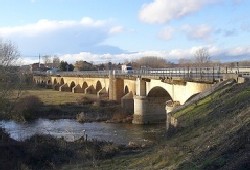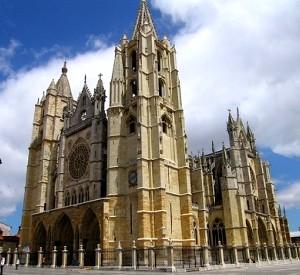Camino de Santiago - French Way - Stage 21, page 1 - Mansilla de las Mulas to León
Total distance: 20 km
Leave Mansilla de las Mulas by crossing a stone bridge over the Río Esla, then take a left onto the old road which soon becomes a track that runs more or less parallel to the main road for about 5 kilometres. As you leave Mansilla de las Mulas you can see in the distance the first signs of the Cordillera Cantabrica mountain range. Up on your right hand side atop a hill are the remains of the Castro de Lancia once populated by Celtic Asturians until the Romans took it in around 24BC. Rumour has it that when the Romans finally captured the fort Emperor Augustus closed the Temple of Juno in Rome, something that was only ever done when Rome was at peace, thus marking the beginning of a period known as Pax Augusta.

Back on the track after 4 kilometres you pass through the village of Villamoros de Mansilla and then 2 kilometres further on you cross the 200 metre long, 20 arched Puente de Villarente over the Rio Pormo and enter the village that shares its name. Be aware that this bridge is extremely busy with traffic so can be pretty dangerous at times. The authorities in this area have mentioned the building of a temporary Pilgrim footbridge, but when this will happen I don't know. The government is also building a new motorway that will pass close by which should alleviate some of the congestion when it is completed some time around 2012.
The village has the usual restaurants, cafés and shops as well as a couple of albergues and a couple of hostals.
Pass through Puente Villarente and after a petrol station on your right you will find the way-marked gravel path which runs parallel to the main road passing through the small village of Arcahueja after about 4.5 kilometres. There is a small albergue here. A couple of kilometres further on you come to the village of Valdelafuente where you can get something to eat at the bar/restaurant.
Unfortunately from here the path disappears and you have to follow the main road. You will start to walk uphill towards the Alto del Portillo from where you will get some great views over the city of Leon and the mountains in the distance. Eventually you come to a bypass called the Avenida de Madrid which veers to your right but you will need to fork left towards the Puente Castro over the Rio Torio. Cross the pedestrianised footbridge about 50 metres from the main bridge and keep going straight on down the Avenida del Alcalde Migue Castaño for about 1.5 kilometres till you come out on the Plaza Santa Ana. Follow the Calle Barahona then the Calle Puertamoneda passing the Iglesia de Santa Maria del Mercado on your right, down the Calle de la Rua and the Calle Ancha until you reach the cathedral in Leon.
Lying on the banks of the Rio Bernesga, Leon is the last major city before you reach Santiago and before you climb through the mountains of the Cordillera Cantabrica. The city was founded as a Roman fort in AD68 to protect the roads leading to the gold mines at El Bierzo a little to the west. The town was home to the Legio Septima or Seventh Legion of Imperial Rome from whence the city is believed to get its name.
Leon was Christianised in the 3rd century becoming the oldest Bishopric (diocese of a bishop) in western Europe. It also became the Christian capital of Spain in the 10th century during the reign of Ordoño II, king of Galicia and Leon until it was destroyed by the Moors some time around 987 AD. It was reconstructed by Alfonso V.
Like its sister city Burgos, Leon is worth spending some time in, especially if you have an interest in architecture, there are some wonderful examples in the city including a building by the famous architect Gaudi.

The first building to visit is the Catedral de Santa Maria, a gothic masterpiece. The building that stands here today was begun in the 13th century and built over the original Romanesque cathedral that in turn had been built over a palace erected by Ordoño II. The palace that the king built had been built over the original roman baths which led to some major problems as we shall recount later.
Over its lifetime the cathedral has undergone some major reconstruction and restoration. Because of its not too suitable building plot, the use of poor quality stone and the sheer weight of the amount of stained glass used (some 1,765 square metres in all), the building became somewhat unstable. Much of the stonework was replaced in the 19th century requiring the removal of whole sections of the building. This in itself is a remarkable piece of engineering as it could well have caused the collapse of the whole building. I tip my hat to those engineers.
Just as you enter the wooden doors of San Juan hanging up in one of the corners are the leathery remains of what most people believe is a mole or Topo Maligno who was blamed for causing all the problems with the building by tunnelling underneath it.
The legend says that a giant mole, that no one had ever seen, would come out at night and destroy the foundations that the stonecutters had laid the previous day. This went on for many weeks bringing construction on the cathedral to a near standstill. Fed up with not being able to get on with their work the stone masons decided to set a giant trap to catch the culprit. Luckily they were successful the first night that the trap was put in place. When the builders went to see what had been caught they couldn't believe their eyes because the mole was so big. They promptly killed the animal and skinned it and hung its carcass above the door to remind everyone of their victory over the destructive mole.
What was actually causing the problems were the myriad of tunnels that had been built as part of the roman baths and not one to put a kybosh on any legend, but recent investigations have also shown that the carcass that hangs over the door is not that of a giant mole but of a giant tortoise.
Continued on Stage 21 - page 2.

